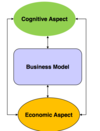Lecture 7 - Business Models and Innovation Flashcards
(16 cards)
What is innovation and what are the different types?
What is innovation?
“The successful commercial exploitation of new ideas” Joseph Schumpeter
Types of innovation:
New products
New processes
New mgmt. forms
New business models
Describe a typology for product innovation
A typology of product innovation
Newness of technology vs. Newness of customer need
Incremental innovation [L,L]
Market breakthrough [L,H]
Technological breakthrough [H,L]
Radical innovation [H,H]

Why introduce new products?
Someone else will – product under 5 years old contribute 30% of profits
Larger firms are slow to innovate (Arrow)
- Greater risk of cannibalisation
- Higher risk aversion
- Innovate incrementally
Large firms are fast to innovate (Schumpeter)
- More resources
Google’s approach
- 70% time on core products
- 20% on relevant but tangential products
- 10% on wild fun that might or might not lead to a product
What are the three forces of innovation?
The forces of innovation
Fear of being supplanted – someone else will innovate (+)
Fear of being dispossessed – preserve ideas for own benefit (–)
Hope of expansion – new idea will extend the market (+)
Explain the innovator’s dilemma
The innovator’s dilemma
Incumbents focus on existing customers (Christensen)
Decreasing returns – incumbents focus on investing to improve current technology

Explain the benefits of lead user analysis
Lead user analysis
Consumers – skateboards
- Information from ‘lead users’
- Motivated to innovate due to benefits from innovation
- Experiences needs earlier (cars vs. aerospace)
- The lead user approach has been shown to generate
- Breakthrough new products at a higher rate than the traditional method
- Higher sales
What are process innovations?
Process innovation
Are defined as elements introduced into a firm’s production or service operation to produce a product or render a service
Are orientated towards the efficiency or effectiveness of production (and distribution) and may result in a decrease in the cost of production
Damanpour
Reviewed the major studies on the effect of size and competition on product or process innovations
Found no evidence of substantial differences in the strength of the influence between the two types of innovation.
What is management innovation
Management innovation
Management innovation is the invention and implementation of mgmt. practice, process, structure or techniques that are new to the state of art and is intended to further organisational goals
The introduction of mgmt. innovation is positively associated with future firm performance, in the form of productivity growth
Examples: modern research lab, Toyota production system, spaghetti organisation
What affects profit from innovation?
Value creation and appropriation
Profits from innovation is impacted by
Innovator’s ability to appropriate the value of the innovation which is impacted by
Property rights in innovation
Complementary resources
Tacitness and complexity of the technology
Lead time

What are the different legal ways to protect IP?
Legal protection of IP
Patents – exclusive rights to a new product process, substance or design
Copyrights – exclusive rights to artistic, dramatic and musical works
Trademarks – exclusive rights to words, symbols or other marks to distinguish goods and services
Trade secrets – protection of chemical formulae, recipes and industrial processes
Also private contracts between firms and between a firm and its employee can restrict the transfer of technology and known how
What are complementary resources?
Complementary resources are key to capture value
Manufacturing
Distribution
Service
Marketing
Finance
Complementary technologies
Bargaining power of owners of complementary resources depends upon whether complementary resources are generic or specialised. When generic the innovator is in better position to capture value, when specialised provides a protection.

Why do firms patent?
- To prevent copying
- For licensing revenue
- To prevent law suits
- To block others
- For use in negotiations
- To enhance reputation
- To measure performance
Describe the 4Vs of the business model
The 4V’s of a business model
Value proposition: who are your customers and what do they value
- Target customers
- Solutions
Value creation: how is the value chain configured
- Production
- Inventory
- Distribution
Value capture: What is the economic logic of making a return?
- Revenue and cost architecture
- Financing
Value Network: what is the role in the value network?
- Partners
- Complementarities

What is a business model innovation?
Business model innovation can occur when there are changes in the components or interdependencies between the components in order to serve an existing market or a new market.
Business models are the “BRIDGE” between technology and the market
Business models have both cognitive and economic aspects. Give examples

Example
ZIPCAR VS HERTZ
BLOCKBUSTER VS NETFLIX
Explain the dominant logic of a business model
Dominant logic: “the way in which managers conceptualize the business and make critical resource allocation decisions.”



